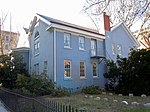Trenton Six
The Trenton Six is the group name for six African-American defendants tried for murder of an elderly white shopkeeper in January 1948 in Trenton, New Jersey. The six young men were convicted in August 1948 by an all-white jury of the murder and sentenced to death. Their case was taken up as a major civil rights case, because of injustices after their arrests and questions about the trial. The Civil Rights Congress and the NAACP had legal teams that represented three men each in appeals to the State Supreme Court. It found fault with the court's instruction to the jury, and remanded the case to a lower court for retrial, which took place in 1951. That resulted in a mistrial, requiring a third trial. Four of the defendants were acquitted. Ralph Cooper pleaded guilty, implicating the other five in the crime. Collis English was convicted of murder, but the jury recommended mercy – life in prison rather than execution. The civil rights groups appealed again to the State Supreme Court, which found fault with the court, and remanded the case to the lower court for retrial of the two defendants who were sentenced to life. One was convicted in 1952 and the other pleaded guilty; both were sentenced to life. Collis English died in late December that year in prison. Ralph Cooper was paroled in 1954 and disappeared from the records.
Excerpt from the Wikipedia article Trenton Six (License: CC BY-SA 3.0, Authors).Trenton Six
North Broad Street, Trenton
Geographical coordinates (GPS) Address Nearby Places Show on map
Geographical coordinates (GPS)
| Latitude | Longitude |
|---|---|
| N 40.22307 ° | E -74.76465 ° |
Address
North Broad Street 216
08608 Trenton
New Jersey, United States
Open on Google Maps






